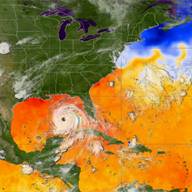As NASA’s large scientific applications scale to greater numbers of processors, this creates Input/Output (I/O) bottlenecks.
Applications like numerical weather prediction models, scientific data-analysis applications, and scientific visualizations can take advantage of LambdaRAM, an approach to memory management developed at the Electronic Visualization Laboratory (EVL). The global forecast models used in the Modeling, Analysis, and Prediction (MAP) project have substantial disk I/O latency in the analysis segment, which idles NASA’s computer processors for 25-50% of the execution time. If this I/O latency is reduced, model results can be obtained faster!
The ability to quickly pre-fetch data from disk storage and temporarily store (or cache) it in a computer’s memory, and then move the data from this “staging” computer to the computer running the weather simulation, assumes that the machines are all connected at high speed.
Based on earlier experience and information gained as an OptIPuter partner, NASA Goddard was able to more easily install several high-speed networks within its facility, which connect to the nation-wide NASA Research & Education Network (NREN) 10Gbps backbone. Ultimately, the machines used to store, access and analyze data can be located at any NASA facility connected to Goddard at high speeds.
EVL recently made modifications to make LambdaRAM work seamlessly with a legacy application to locally access large data files. LambdaRAM allowed NASA to transparently access data files across multiple servers over high-speed networks, instead of from local disks. The next step is to analyze the performance of LambdaRAM and extend the work to other NASA applications, such as MAP.
OptIPuter-developed network tools being developed by UIC/EVL (and tested over IRNC links with OptIPuter partners in the Netherlands) are getting interest from other communities.
URL:
www.evl.uic.edu/cavern/optiputer
www.evl.uic.edu/cavern/lambdaram
Collaborators:
University of Illinois at Chicago, Electronic Visualization Laboratory (UIC/EVL)
NASA Goddard Space Flight Center, Software Integration & Visualization Office
